Russell Hobbs K2 kettle - a collectors' guide
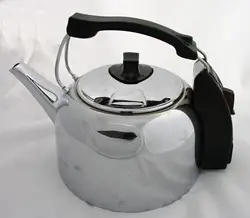
- Production run: 1960 to 1982
- Designer: William Morris Russell
- Where was it made: Croydon, South London, later Wombourne, Staffordshire
- Value today: £20 to £200
The Russell Hobbs K2 was the first kettle that switched itself off when the water boiled. To many people it was a much loved old friend. In recent years it has become the most desirable kettle that everyone wants in their kitchen.
The K2 was a premium product; it was just about the most expensive kettle you could buy at the time. Before the mid-1970s it was the only kettle that could switch itself off, known in the trade as an automatic kettle. It was well made and had a reputation for longevity that the jug kettles which superseded it could not compare with. Many people are still using K2s more than thirty years after they first bought them.
Today it is by far the most collectable mass-produced kettle.
Short history
The Russell Hobbs Company was the partnership of William Morris Russell and Peter Hobbs. They both served as majors in the army during the Second World War and they both joined Morphy Richards soon afterwards, with Peter Hobbs becoming managing director of Morphy Richards in South Africa and William Hobbs working as an engineer and designer.
Peter Hobbs parted company with Morphy Richards to join another firm. He later contacted Russell to help develop a ceramic electric coffee percolator. Both men decided they would do better on their own and formed Russell Hobbs, the perfect partnership of salesman and engineer.
Although the coffee percolator did quite well in the prosperous 1950s, it was their next product, an electric kettle, which really took off. Russell's first electric kettle, the K1, had a vapour control system which switched the kettle off just as the water came to the boil. This was revolutionary; no other kettle had such a system and it was so easy to forget and leave a kettle to boil dry. Later advertising called the K2 the Forgettle.
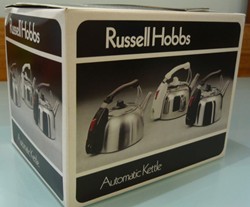
The K1 was a bit of an ugly duckling and Russell, who always believed that well designed products sold themselves, improved the design to create a design classic in the K2. The company launched the K2 in 1960. It achieved a place on the coveted Council of Industrial Design (COID) index, only one of two kettles in the 1960s.
In 1963 Russell and Hobbs sold Russell Hobbs to Tube Investments (TI) which ran the firm as a separate business until the 1980s. The K2 also continued and was improved along the way. A new model the K2R, 'R' for rapid, had already been launched in 1962 and a new stainless steel model, the K2S, joined the K2R later in the 1960s.
In 1982 Russell Hobbs finally replaced the K2 with the K3. A similarly solid and well engineered product, the K3 continued to sell well against modern opposition in the form of the plastic jug kettle.
Models
Over its lifetime, there were several variants of the K2:
- K2 - Chrome plated copper
- K2R - Chrome plated copper, rapid heat element
- K2S - Brushed stainless steel, rapid heat element
- K2SPW - Chrome plated copper with white handle, switch cover and lid knob
- K2P - Polished stainless steel
All K series kettles have the model number on the base so they are easy to identify.
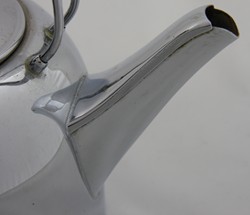
K2 (1960)
The first version was launched by Russell Hobbs in 1960. It was made from chrome plated copper. In the post-war era chrome plated copper replaced traditional Victorian style copper.
The original K2 had a 1750 watt element and could hold three pints of water.
Later in the 1960s the K2 was phased out. So all K2s date from the 1960s.
How do you identify a K2?
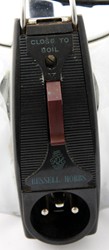
The K2 is marked on the base 'VAPOUR CONTROLLED ELECTRIC KETTLE MADED IN ENGLAND BY RUSSELL HOBBS LIMITED TYPE K2 CAPACITY 3 PINTS'
K2s are always chrome plated copper. They have a curved spout (see photograph, above left).
Very early models have a 2 pin electric plug socket connector. Later versions have the round 3 pin type. Look out for early versions that have 'Patent Pending' on the base. The patent was granted in 1962. It is likely that the patent would have been stamped on the base soon after.
Also look out for blue lettering and the fancy script Russell Hobbs logo on the back of the plastic cover above the plug socket connector (see photograph, right).
Later kettles had white lettering and the logo disappeared (see photograph, right below).
K2R (1962 to 1982)
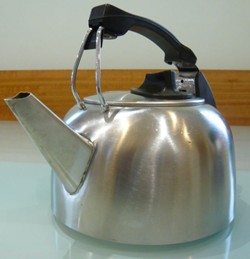
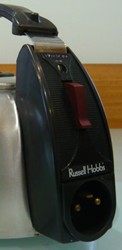
The K2R was the definitive Russell Hobbs kettle. It was an improved version of the K2, with a 2400W, element and it remained in production from 1962 until the K2 was phased out in 1982.
Older versions, pre 1979, had a curved spout; later versions had a straight spout. Otherwise it was pretty much unchanged from the original design.
K2S
Sometime around the end of the 1960s, Russell Hobbs added a new model to the K2 range, the K2S. 'S' stood for stainless steel. It had the same 2400W element of the K2R and was finished in brushed stainless steel (see photograph, left).
Like the K2R later versions had a straight spout (as in the photograph, above left).
K2SPW (1970s)
This must be the rarest K2. It was finished in chrome plated copper and had a white handle, white cover for the thermostat and a white knob for the lid. I have seen pictures of a copper one as well. This may have been a factory one-off.
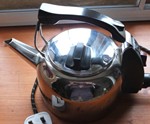
K2P
I know very little about the K2P (see photograph, left). It appeared towards the end of the K2 production run, probably in the 1980s. I am surmising that P stood for polished and it was stainless steel in a polished finish. The K2P had a straight spout and a squarer handle on the lid to the older versions. There also appears to be no vent on the lid.
Values
K2 values have increased in recent years. It is important that kettles are in working order with no leaks and have no major damage. Some signs of wear on older models are acceptable.
Unused in original box
Box in good condition, kettle as new
- K2R - £100 to £200
- K2S - £60 to £160
Good condition
Kettles in working order, presentable condition and no leaks or other faults:
- K2 - £30 to £60
- K2R (curved spout) - £30 to £50
- K2S (curved spout) - £20 to £30
- K2R (straight spout) - £15 to £30
- K2S (straight spout) - £10 to £30
- K2P (straight spout) - £15
Poor condition
Kettles with faults or poor condition
- All models except K2SPW or early 1960s K2 - £10
Useful links and reference material
- The Secret History of the Russell Hobbs K2 Kettle by Kate Watson Smyth, published in The Independent
- Design Classics #21: The Russell Hobbs K2 Kettle blog article by Kate Watson Smyth
- Russell Hobbs Futura - the replacement for the K2?
Article by Steven Braggs, March 2014


Comments
I was press shop quality control at Russell Hobbs. The K2 was before my time but I worked on all from K3 to K5. If my memory serves me correctly the K5 was the first version to offer a cordless version facilitated by the new flat elements that RH pioneered. Personally I think the K3 was the best, even better than the K2 but not quite as elegant and not considered a design classic. The quality level was overkill. We used to scrap hundreds of the body shells for the slightest cosmetic blemishes that I'm sure no customer would have noticed.
I have 2 new copper K2R still boxed although 1 has tarnished can you value them for me.